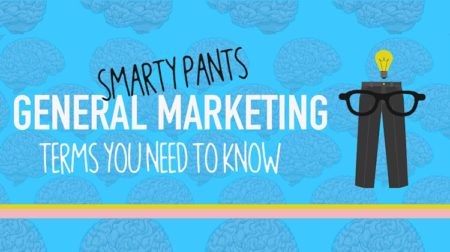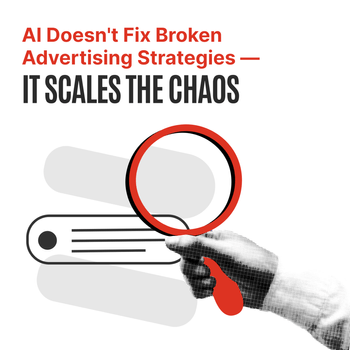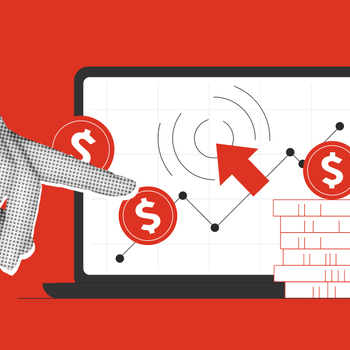Be a Marketing Smarty Pants: Marketing Terms You Need To Know
by Cydney Hatch • August 8, 2018
“Okay Mr. Rogers, let’s review your blood results from two weeks ago. Your CBC, BMP, and LFTs came back negative. You have prediabetes and since your BMI is 28, you should watch your diet to prevent further complications…”
What?
“Okay Mr. Rogers, it seems as though your case refers to an incident of battery on June 16th at 2:00AM? Correct..?”
What?
“Okay Mr. Rogers, how are you liking your time so far being a part of the “chair force…?”
What?

Using the examples above, I think its fair to use the metaphor “it’s all Greek to me,” as these terms are ones many of us don’t really understand. Like any person, in your work field you will learn to pick up lingo, acronyms and other languages that relate to your work space. Whether it’s understanding what BMI, battery or “chair force” is, you will need to understand your career terms if you are going to excel or fit into the world around you.
Marketing is no exception.
As marketers, we need to be a “smarty pants” in not only general marketing terms but in business, social media and the varying specifics of marketing campaigns. Marketing has tons of confusing acronyms and other lingo that can leave anyone’s head spinning. Not only that, but this field is constantly evolving, which means you have to stay up to date on platforms, terms and applications that are evolving and being created.
So, to help you wear the many pairs of “smarty pants” that will be required of you, and to stay up to date, let’s look at the many marketing terms you will need to know so you can excel in the marketing field!
Marketing Terms You Need To Know
Knowing the following terms will set you apart so you can show off and be the “smarty pants” of your conversations, office and field. Knowing these terms means that you’re staying up to date with the ever-evolving language within the marketing industry.
Let’s get started!
General Marketing Terms
Generally, there are just common lingo terms you need to understand to have a conversation with a marketer. If you are new to marketing, here is a solid list of marketing terms you need to have in your vocabulary! Luckily, most of these do not change and evolve, so know these basics!
A/B Split: Also known as A/B testing, this is where you compare two versions of something, whether ‘an app, webpage, landing page or email campaign. By simultaneously testing these two elements, you can see which ones performs with your target audience.
AI: Artificial intelligence (AI) is a computer system simulation of intelligent human behavior in computers. An example of this in our modern day is chatbots.
Algorithm: A complex mathematical approach used to assess hundreds of millions of data points to predict behavior and increase the relevance of content displayed to a user. You see these being implemented in social media displays and Google ranking.
Analytics: Data that can help spot trends in your marketing. This data can be gathered on different marketing platforms.
Average Revenue per Unit (ARPU): The average revenue your company makes per unit of product. The formula for this is usually ARPU = total revenue / number of customers.
Business to Business (B2B): Businesses and sales between two businesses.
Business to Consumer (B2C) : Business and sales between a business and a consumer.
Big Data: Large sets of data that are analyzed to accurately spot trends in marketing and consumer behavior.
Bottom of the Funnel: A stage in the buying process where a customer is closing to buy.
Brand/Branding: The character and design choices that define your brand. It is the aesthetic that is presented to your target audience.
Buyer Persona: A summary of your ideal buyer, based on market research, data and hypothesis.
Call-to-Action: A line of text or image that prompts visitors or customers to take action on a piece of marketing material.
Content Management System (CMS): A program that manages all of the aspects of creating content. These may include editing, indexing, navigational elements, etc.
Conversion Rate: The rate at which your customers complete a conversion step.
Cross-Channel Marketing: A type of marketing that shares your marketing messages across multiple platforms such as website, social media and print.
Customer Acquisition Cost: A measurement that allows you to assess the cost of scaling up your business.
Customer Insight: An observation on the behavior of your target customers that marketers can use to make a better and more targeted marketing messages.
Customer Journey: The path a potential customer takes to buying your product.
Cost Per Click (CPC): Cost Per Click is the cost you are willing to pay for the traffic you will get from your Pay-Per-Click ad (PPC). CPC is a way to gauge your ad campaign success and your ultimate goal: money or return on investment (ROI).
Cost Per Lead (CPL): The total cost marketing pays to acquire a new lead.
Customer Relationship Management (CRM): Software that helps you organize all of your marketing and sales activities, including storing contact information, tracking emails, storing deals, and more. Salesforce is one of the best-known CRM platforms.
Demographics: Data profiling of target customers using concrete measures like age, gender, race, income, family life, hobbies, etc.
Digital Marketing (Online Marketing): Marketing to a target audience solely in a digital way on the internet.
Direct Marketing: This form of marketing is focused on direct communication with the decision maker of the buying process via marketing, communication or advertising.
Display Advertising: Display ads are the ad boxes that are on the tops or sides of a website. They can be traditional banner ads or even videos.
Ecommerce: Selling products digitally on the internet.
Geo-Targeting: Targeting people based on their physical location.
Inbound Marketing: Unlike outbound marketing tactics like cold calling or emailing, inbound marketing focuses on getting new prospects to reach out to you. Aside from cold emailing, most online marketing tactics fall under the umbrella of inbound marketing.
Keywords: Keywords are words that your business wants to rank well for in the search engine report page (SERP). You can target keywords through either paid search or search engine optimization.
KPI: KPI means key performance indicator. KPI’s are measurable data pieces that prove success, growth and your business is on track.
Landing Page: Landing pages are web pages that a person is taken to after clicking an ad. Landing pages are separate from your main website pages and are designed to receive campaign traffic.
Marketing Qualified Lead: A prospect who has expressed interest in your product and your marketing team has determined that they would be ready to talk with a salesperson.
Market Research: Research made to make better marketing and business decisions based off of your industry needs, trends and interests.
Niche Market: A highly specific subset of a larger market audience with unique needs and interests.
Omnichannel: A marketing tactic that covers many marketing channels/platforms.
Pain Points: The problems or pains that your target market is currently experiencing. These are strong marketing clues on how to best market your products or services towards your audience.
Pay Per Click (PPC): Pay Per Click (PPC) refers to a type of online marketing where you pay every time your ad is clicked.
Responsive Design: A website that is optimized for use on multiple devices such as mobile, laptop and desktop.
Retargeting: Remarketing or retargeting allows you to track users who have visited your website—without a purchase or action—and shares your ads on other websites. Think of this as the ultimate digital stalking, products will stay on your mind and follow you!
ROI: Return on investment is the money you make per dollar spent on the marketing you used to market your product or service.
Sales Funnel: The entire sales process as a whole—from prospect to paying customer—and all marketing, advertising and sales processes in between.
Sales Qualified Lead: A sales qualified lead is generally a lead that the sales team has contacted and is moving forward through the sales process.
Search Engine Optimization (SEO): SEO stands for search engine optimization. It’s a process that uses certain best practices to rank well with search engine algorithms which determine how far up on pages a website is listed.
Strategy: A holistic plan that contains a business’s marketing goals and how a business plans to reach them.
Tactics: The marketing efforts that you use to reach your objectives and goals.
Target Audience: The group of people that your organization is trying to reach due to them being the best fit for your business products and services based off of interest or need.
Social Media Marketing Terms
Social media is a beast as its always evolving and new trends are always coming in and out. To stay on top, here are some social media marketing terms you need to master and take to heart!
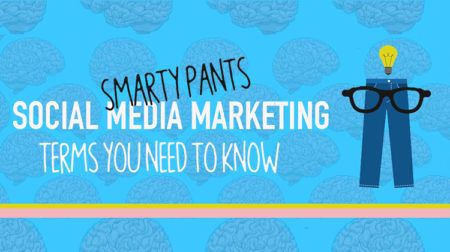
Avatar: In forums in social media, avatars are visual representations of individuals online via an image, graphic, or username.
Average Response Time The average time which a company or an individual takes to reply to their customer’s issue or query on social media messaging.
Bit.ly: A free link management platform. It is mainly used to convert long URLs into a short link for social sharing.
Engagement Rate: The rate at which your followers engage with your content on social media.
Facebook: Facebook is one of the biggest social media platform where users can post, share, read, view information about a brand or an individual.
Followers/Fans: Social media users who have chosen to follow your social media accounts.
Geotagging: Geotagging is adding a geotag in the form of metadata to various images, videos, and data posted online. It is a geographical information attached to the content. This is usually found on Instagram.
GIF: Graphics interchange format (GIF) is a short animated file used to express an emotion, thought or attitude visually.
Handle: Handle is a username on social media like Twitter and Instagram. An example of this would be our handle @DisruptiveAds on Instagram and Twitter.
Hashtag: A phrase preceded by a # that identifies posts about a particular topic (for example, #disruptiveads). This is a way for social media platforms to organize posts based off of content topics.
Influencer: An influencer is a person who has established credibility in a specific industry niche. A influencer can be a YouTube Channel star, blogger, industry expert or social activist.
Influencer Marketing: An ecommerce strategy that focuses on using influencers to drive a business message to the influencer’s audience.
Impressions: The number of times your content is shown in a newsfeed.
Instagram: Instagram is one of the biggest picture sharing social networks. Users can click a picture, apply a filter and post it on their account.
Like: An actionable way of expressing that a user likes your post.
LinkedIn: LinkedIn is networking site for business professionals.
Live Streaming: Live streaming is a way of broadcasting video to users in real time. People can also interact with the person or company who is streaming the video live. This is extremely popular on Instagram and Facebook.
Meme: A meme is an image or a video with text designed to be humorous.
Mention: When your handle is included in a post it is referred to as being “Mentioned.” Your handle will appear in the post preceded by an @ sign. This tags your business or individual in a post for traffic reasons.
News Feed: A feed or display of social media posts that are created based on people a user is friends with and pages they follow.
Organic Traffic: Visitors to your webpage who have not been influenced by an ad or paid content.
Page Views: The number of times your webpage has been viewed.
Pinterest: Pinterest is a content sharing online website and an app through which people can share multimedia and can “pin” images, videos or quotes into their pinboard.
Reach: The total number of people who see a post.
Reactions/Likes: A way that social media users can show feedback on content your business puts on social media through emoticons, likes or comments.
Skype: Skype is a widely used website and application for having a video call with your friends and family.
Social Proof: A social and psychological phenomenon where users trust a product or piece of content more based on the number of people who say they use it or like it (often reflected in terms of likes, follows, and shares).
Snapchat: Snapchat is a trending application right now and is primarily used for sharing a 10 second live video or a picture with friends. Brands can also use geotags and post live videos on their accounts.
Social Media Campaign: A series of social media posts that are centered around a specific message that encourages your audience to take some type of action.
Social Media Monitoring: The act of monitoring and responding to comments, likes and engagement with your business’s social media pages.
Sponsered Post: A sponsored post is a paid post by a brand to reach a specific number of audience and to generate traffic on their website for making further sales.
Tumblr: Tumblr is a microblogging and social networking website which allows a user to a share and post various multimedia like images, GIFs, music, videos, quotes etc.
Twitter: Twitter is one of the biggest social media sharing website where a user can read and post tweets which is only limited to 140 characters. Now, a user can also post GIFs and videos in addition to the tweets.
Unique Visitor: A website visitor who has visited a specific web page at least once in a certain time period. A unique visitor is identified by their IP address.
User-Generated Content: Content that has been created by fans of your organization about your product or service.
Viral Spread: It is a way of seeing that how quickly a news, image or a message is spreading across the various social media platforms.
Vimeo: Vimeo is an online video sharing website and app in which a user can view, share and upload a video.
YouTube: YouTube is the biggest video sharing website and is widely used. A brand can target a huge chunk of audience via YouTube Ads.
Content Marketing Terms
Content marketing, whether that be blogging, whitepapers, eBooks or podcasts, really works if you do it correctly. Each time you publish engaging content, you’re creating a new opportunity to get found on search engines, social media, and by new potential clients. Here’s the lingo you need to know to discuss it correctly.
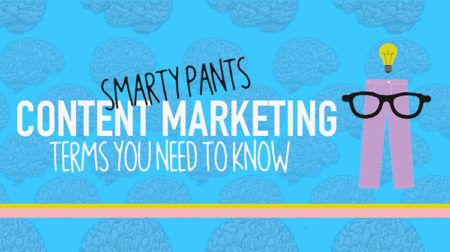
Above the Fold: The first space in your web page that appears on a screen before a visitor needs to start scrolling down.
Affiliate Marketing: An arrangement between two companies to promote one or both companies’ to potential customers.
Black Hat: A term that refers to the use of unethical techniques to try to “beat” the system. If caught engaging in black hat practices, businesses or individuals are penalized or blacklisted from sites.
Blogging: The action of writing articles, commentaries, and creating visual content regularly on a website. Blogging helps to drive website traffic, builds thought leadership and authority, and drives leads.
Branded Content: Content that is created by a brand and published on another site.
Call To Action: A call to action (CTA) is an indirect order given by a business to a target audience encouraging them to take an action that benefits the business.
Case Study: A research process where a specific topic/organization is studied in detail.
Click Bait: Catchy, often viral content that is used to capture clicks, but often has little to no journalistic value. It is the Inquirer newspaper of the internet!
Content Management System (CMS): A software program that helps users create and manage their online content. WordPress, Drupal, and Expression Engine are all popular CMS tools.
COPE: An acronym for “Create Once, Publish Everywhere,” which refers to creating content intended for multiple uses across a variety of platforms. An example of this would be writing an eBook that can be broke down into several marketing content pieces like infographics, white papers, blog posts and social media posts.
Content Strategy: The process of planning and managing content for distribution.
Disqus: Disqus is a blog comment hosting system which lets you build up a community on your blog where you and your users can interact, discuss queries with each other to increase the user interaction engagement.
Dynamic Content: Content that automatically changes based on user interactions. They can often help determine what content needs to be delivered to a user at what time.
Earned Media: Publicity gained without paid advertising. This can be features in magazines, shares or features.
Ebook: An eBook is an electronic book which can be read online. It is usually in a PDF format and available online for a purchase price or free.
Editorial Calendar: A calendar that helps marketers keep track of what content is being published and when.
Evergreen Content: Content that is relevant for a prolonged period, usually years.
Filler Content: Information or data that people copy from other sources and publish it on their page, account, or website.
Microsite: A website that shares specific branded content that is a secondary to your larger main site. This is usually involving one topic, product or service in more detail.
Native Advertising: Native advertising is paid content that is shared on a publication site that aligns with a business’s established style and provides the kind of information that the site’s audience wants.
Original Content: It is a self-made content out of research and ideas. Audience and search engines, both love original content and you will usually rank higher on searches if your original content is deemed as valuable to readers.
Podcast: Podcast is a digital audio file series created by a user and is available for download on the Internet.
Viral Content: Digital content that suddenly becomes rapidly popular on social media platforms.
Webinar: Online seminars or presentations held by a company, team or individual to teach or inform about a topic to the audience. These can be either LIVE or pre-recorded for the audience.
White Paper: A document that argues a specific position or solves a problem for its audience.
Digital Marketing Terms
Digital marketing is always changing and evolving, so here are some of the terms you should keep in mind when talking about digital marketing.
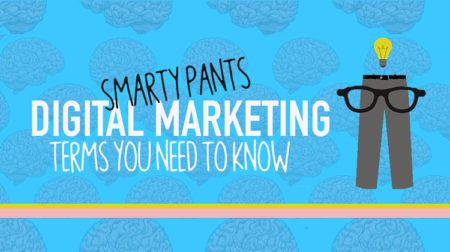
Bounce Rate: The rate at which a user lands on your web page and leaves the site after only viewing one page.
Chat Bots: An automated messaging system that automatically interacts with your customers via online chat.
Cookies: Small files placed on consumers’ computers in order to uniquely identify the user in an anonymous way. This allows technology platforms to learn about consumer’s interactions with ads and content.
CRO: Stands for conversion rate optimization. CRO describes a site testing process designed to increase the percentage of customers who visit your site and then take a conversion step.
Domain Authority: A search engine ranking metric that predicts how well your your website will rank on a search engine.
Inbound Link: Links that point back to a page on your website from another site.
Marketing Automation: The process of intelligently and automatically sending content to your website visitor based on the the actions they take or the way they interact with your website.
Mobile Marketing: A type of marketing strategy that optimizes content so it is easily viewed on a mobile device.
NPS (Net Promoter Score): A tool that measures customer experience and relationships they have with their consumers.
UX: Stands for User Experience. User experience is the emotional attitude and reaction that your visitors have when interacting with your website.
UI: Stands for User Interface. A UI includes all of the graphical controls someone would use to interact with your website such as drop-down menus, buttons, etc.
USP: The unique selling proposition that your company offers. This is what differentiates your product from your competitors.
Email Marketing Terms
Email marketing is its own beast with terms and processes specific to its marketing world.
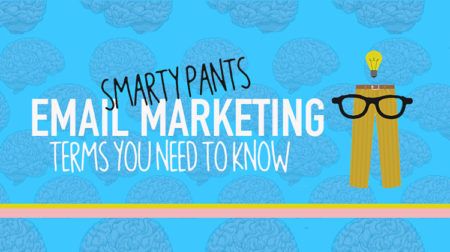
CPO (Clicks Per Open): The ratio between clicks and opens that an email received.
ESP: Email service provider (ESP), ie. Gmail, Yahoo, etc. Tools like MailChimp, Campaign Monitor and others are sometimes referred to as ESPs as well.
Hard Bounce: An email message that has been returned to the sender because the email address doesn’t exist or the user has blocked their address.
List Segmentation: A way to divide your email list into specific categories bases off of actions, demographics or other categories of interest for the campaign.
Open Rate: The number of times your email was opened in a mass send.
Open Length: The time a user has spent with one email open before closing it.
Pre-header: A short summary that follows a subject line that appears before an email is opened.
Spam Trigger: Words in an email that cause it to be marked or flagged as spam.
Sender Score: A score that organizations can receive based on how likely their emails are to reach their subscriber’s inbox. (1-100)
Soft Bounce: An email that is sent to the recipient but returned back to the sender before it can be opened.
Subject Line: The line in your email that tells your recipient what to expect when they open it.
Ta-Da: You Are Now A Marketing Term Smarty Pants!
Feeling smart? Good, now take your new found knowledge and impress some people! You are a marketing terms smarty pants!

You’ve now got a really useful resource in case a term ever comes up that you’re unfamiliar with. If you need some more help or if you want something explained in more detail, make sure you see more of our “guide” blog posts here at Disruptive or feel free to reach out to me in the comments section!
How did you best learn marketing terms? Share resources below!


